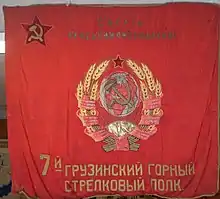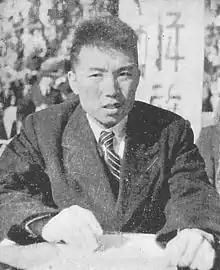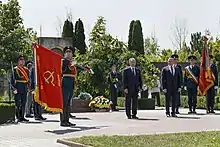National military formations of the Red Army
A national military formation (Russian: Национальные воинские формирования) refers to a regiment/division in the Soviet Red Army of the Soviet Union, formed before and during the Second World War on the basis of nationalities of the personnel in their ranks. In addition to national units, representatives of all nationalities served in ordinary military formations not divided according to national or other grounds.

Historical summary
In its first days of its existence, the Red Army had a tradition of forming national military units (which continued the trends that existed before the revolution), either openly (a unit with a "national" name was created, staffed mainly by representatives of the same nationality), or by the "concentration" method, in which conscripts of the same nationality were sent to one compound.[1] Many similar units in the former Imperial Russian Army had existed for years, with many national Bolshevik military units taking part in the October Revolution of 1917.[1] During the Russian Civil War,[2] national units had what was considered to be an impressive battle record.[1] It was the brainchild of Mikhail Frunze, who made sure that national formations were of different sizes, ranging from platoons to divisions.[2] For the training of military personnel of these units, special educational institutions were created. As a rule, national formations served in the areas where they were formed. The existence of units like these were controversial in the Soviet leadership, who believed that they couldn't be able to control them.[1]
The proportion of soldiers of the Red Army serving in national military units has always been small. At the beginning of 1938, less than 2% of the Red Army served in national formations. In 1934, the Belarusian and Ukrainian national units were disbanded and in 1938, a special decree of the Central Committee of the Bolshevik Party and the Council of People's Commissars "On National Units and Formations of the Red Army", abolished all national formations and introduced a unified national procedure for military service for representatives of the country's ethnic communities.[3] The outbreak of the Second World War a year later and the Great Patriotic War two years after that forced the Soviet government to reverse this decision. The reformation of the national units resumed in August 1941 by order of the State Defense Committee, two months after the start of Operation Barbarossa. This was meant to be a counter to the collaborationist formation composed of Soviet nationals on in occupied parts of the USSR (such as the 29th Waffen Grenadier Division of the SS "RONA", the Armenian Legion, and the Turkestan Legion).[1] The first formation ever raised was the 201st Latvian Rifle Division, with 90% of its personnel being residents of the Latvian SSR and more than half consisting of ethnic Latvians. Many national formations lost their nationality specification after the war, continuing to exist in numbers until the 1950s.[4]
List of units
Azerbaijan SSR
- 27th Mountain Division
- 77th Mountain Rifle Division named for Sergo Ordzhonikidze
- 151st Infantry Division
- 217th Infantry Division
- 223rd Infantry Division
- 227th Infantry Division
- 271st Rifle Division[5]
- 396th Infantry Division
- 402nd Rifle Division
- 416th Rifle Division
Armenian SSR[6]
- 390th Rifle Division
- 408th Rifle Division
- 409th Rifle Division
- 89th Rifle Division
- 76th Rifle Division[7]
- 201st Rifle Division
- 17th Mountain Rifle Division[8]
Bashkir ASSR
- 16th Guards Cavalry Division[9]
- 113th Cavalry Division
Buryat-Mongolian and Yakut ASSR
- 321st Infantry Division
Chechen-Ingush ASSR
- 114th Cavalry Division[10]
Estonia SSR
- 8th Estonian Rifle Corps
- 7th Rifle Division
- 249th Estonian Rifle Division
Georgian SSR

- 9th Mountain Rifle Division
- 47th Mountain Rifle Division "Comrade Stalin"
- 63rd Mountain Rifle Division "Mikhail Frunze"[11]
- 276th Red Banner Rifle Division
- 296th Rifle Division
- 349th Rifle Division
- 392nd Rifle Division
- 406th Rifle Division
- 414th Rifle Division
Kabardino-Balkarian ASSR
- 115th Cavalry Division
Kalmyk ASSR
Kazakh SSR
- 100th Kazakh Rifle Brigade
- 101st Separate Rifle Brigade
- 102nd Separate Rifle Brigade
- 151st Separate Rifle Brigade
- 105th Cavalry Division
- 106th Cavalry Division
- 196th Infantry Division
Kirghiz SSR
- 107th Cavalry Division
- 108th Cavalry Division
- 109th Cavalry Division
Latvian SSR
- 76th Latvian Special Rifle Regiment
- 1st Latvian Night Light Bomber Aviation Regiment[12]
- 201st Latvian Rifle Division
- 43rd Guards Rifle Division
- 308th Latvian Infantry Division
- 130th Rifle Corps
Lithuanian SSR
Moldovan SSR
- 14th Assault Engineering and Combat Brigade[13][14]
- 507th Army Anti-Tank Kishinev Artillery Regiment
- 95th Rifle Division, First Formation. Formed 1927, "Moldovan" designation given c. 16 January 1934. See ru:95-я_стрелковая_дивизия_(1-го_формирования).
Tajik SSR
- 17th Guards Cavalry Division (founded as the 20th Tajik Mountain Cavalry Division)
- 98th Rifle Brigade
- 99th Rifle Brigade
- 104th Cavalry Division
Turkmen SSR
- 68th Mountain Rifle Division[15]
- 18th Cavalry Division
- 62nd Turkestan Rifle Division
- 72nd Mountain Division
- 97th Cavalry Division
- 98th Cavalry Division
- 87th Separate Rifle Brigade
- 88th Separate Rifle Brigade
- 128th Guards Mountain Rifle Division[16]
Uzbek SSR
- 19th Cavalry Division
- 89th Separate Rifle Brigade
- 90th Separate Rifle Brigade
- 91st Separate Rifle Brigade
- 92nd Separate Rifle Brigade
- 93rd Separate Rifle Brigade
- 94th Separate Rifle Brigade
- 95th Separate Rifle Brigade
- 96th Separate Rifle Brigade
- 97th Separate Rifle Brigade
- 99th Cavalry Division
- 100th Cavalry Division
- 101st Cavalry Division
- 102nd Cavalry Division
- 103rd Cavalry Division
Formations for nationalities outside the USSR

The 88th Separate Rifle Brigade was unique in that it incorporated the peoples of Korea, China and Soviet Central Asia in its ranks.[17] This unit was founded in July 1942 to accommodate the remaining forces of the Northeast Anti-Japanese United Army, who were exiled to the Soviet Union after being driven by the Imperial Japanese Army to Manchuria during the war. Chinese Major General Zhou Baozhong was commander of the brigade.[18] Notable members have included Kim Il-sung, Lim Chum-chu and Kim Chaek.
Notable commanders and members
Legacy of national formations in the twenty-first century
- In a ceremony that preceded the Shushi Liberation Day and Victory Day parade in Yerevan in 2020, the Armenian Honour Guard Company took the combat flags of the six Armenian national divisions out of the Mother Armenia Military History Museum and handed them over to Armenian veterans of the war.[20] Then, the six veterans were driven to the airport, where they handed the banners to the pilots participating in the flypast over the capital.[21]
- During the commemorations of the 75th anniversary of the Jassy–Kishinev Offensive in 2019, the center of which was a national ceremony at the Capul de pod Șerpeni Memorial Complex, Russian Defense Minister Sergey Shoigu ceremonially handed to his Moldovan counterpart the military flags of two all-Moldovan regiments who participated in the offensive (including the 14th Assault Engineering and Combat Brigade), which until that point, were kept at the Central Armed Forces Museum.[22]
- In Taganrog, on the Sambek Heights, there is a memorial complex known as the Glory Memorial in honor of the 416th Azerbaijani Division, opened in 1980 at the personal initiative of the First Secretary of the Central Committee of the Communist Party of Azerbaijan Heydar Aliyev. It was restored in 2011.[23]
Gallery
 A flag ceremony in Moldova.
A flag ceremony in Moldova. A color guard led by the Banner of Victory carrying the banners of national army units based in the Azerbaijan SSR during the 2020 Sea Cup.
A color guard led by the Banner of Victory carrying the banners of national army units based in the Azerbaijan SSR during the 2020 Sea Cup.
See also
References
- Безугольный А. Ю. Призывное законодательство и комплектование Рабоче-Крестьянской Красной армии представителями нерусских национальностей в 1920-е гг. // Вестник Калмыцкого института гуманитарных исследований РАН. — 2013. — № 3. — С. 102.
- Безугольный А. Ю. Национальные формирования РККА в 1930-е гг. // Вестник Калмыцкого института гуманитарных исследований РАН. — 2016. — Т. 27. — № 5 (27). — С. 67.
- Подсчитано по списку соединений ниже
- "271 стрелковая дивизия. Вспомним о пехоте (Владимир Пузиков) / Проза.ру". proza.ru.
- "Every fifth Armenian left for the frontline... "In the victory over fascism, the Armenians, from private to marshal, immortalized their names with non fading glory of brave warriors."". www.mfa.am.
- "САВАШ - Военно-исторический сайт". savash-az.com.
- "Голуб Ю., Любин Д. Закавказский фронт Великой Отечественной войны: участие войск фронта в Иранской операции в августе 1941 года" (PDF). Archived from the original (PDF) on 2018-02-19. Retrieved 2018-07-18.
- "Башкирские кавалерийские дивизии". Archived from the original on 2008-07-02. Retrieved 2008-06-27.
- Депортация 1944 года. Мифы и реальность Archived 2008-09-06 at the Wayback Machine
- 63-я горнострелковая дивизия
- "1 нбап". allaces.ru.
- "Новости Минобороны. В Шерпенах стартовала акция «Дороги памяти» к 75-летию Великой Победы". www.patriot-expo.ru.
- "Сергей Шойгу передал Павлу Войку боевые знамена воинов, освободивших Молдову". ru.sputnik.md.
- 68-я Туркестанская Краснознаменная горнострелковая дивизия
- 128-я Туркестанская Краснознаменная гвардейская стрелковая дивизия
- Легендарная восемьдесят восьмая бригада. Аргументы времени - военно-патриотическое издание. 3.02.2016
- 寸麗香 (2011-12-23). "金日成父子與周保中父女的兩代友誼" (in Chinese). 中国共产党新闻网. Retrieved 2019-06-01.
- "Гаврюченков Юрий Фёдорович. Ким Ир Сен". samlib.ru.
- "Victory: May 9". www.mil.am.
- "Armenia and Artsakh Celebrate Victory Day and Shushi Liberation • MassisPost". May 10, 2020.
- "Șeful statului a participat la ceremonia comemorativă de la Complexul Memorial „Capul de Pod Șerpeni"". www.presedinte.md.
- "Восторг маршала Жукова и флаг над Бранденбургскими воротами. Как воевала легендарная 416 Таганрогская Азербайджанская дивизия | Информационный портал moscow-baku.ru". moscow-baku.ru. Retrieved 2020-11-28.